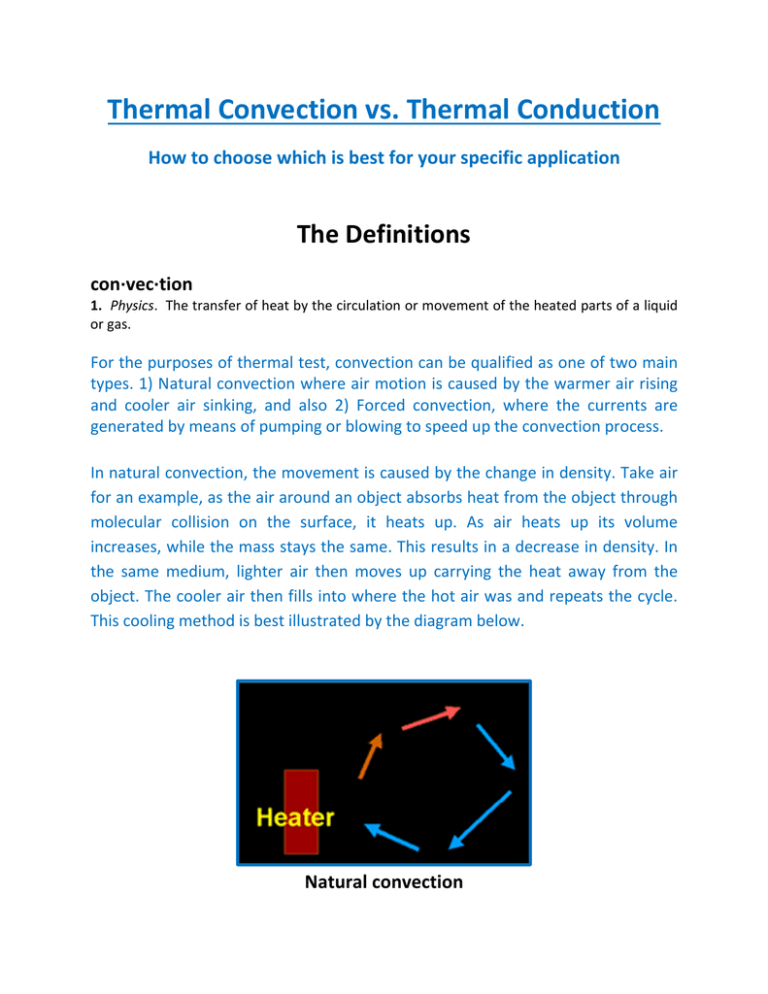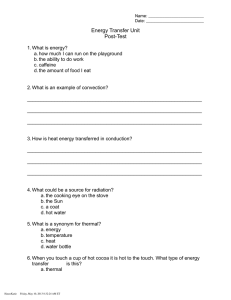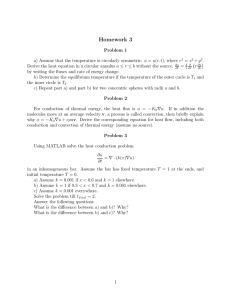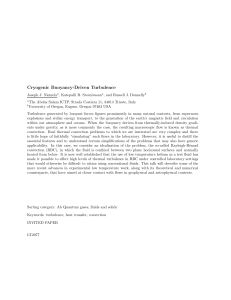Thermal Convection vs. Thermal Conduction
advertisement

Thermal Convection vs. Thermal Conduction How to choose which is best for your specific application The Definitions con·vec·tion 1. Physics. The transfer of heat by the circulation or movement of the heated parts of a liquid or gas. For the purposes of thermal test, convection can be qualified as one of two main types. 1) Natural convection where air motion is caused by the warmer air rising and cooler air sinking, and also 2) Forced convection, where the currents are generated by means of pumping or blowing to speed up the convection process. In natural convection, the movement is caused by the change in density. Take air for an example, as the air around an object absorbs heat from the object through molecular collision on the surface, it heats up. As air heats up its volume increases, while the mass stays the same. This results in a decrease in density. In the same medium, lighter air then moves up carrying the heat away from the object. The cooler air then fills into where the hot air was and repeats the cycle. This cooling method is best illustrated by the diagram below. Natural convection Forced convection occurs when a fluid flow is induced by an external force, such as a pump, fan or a mixer. A typical example of forced air convection using a fan is shown below: Forced Convection In forced air convection, the most common thermal test method is with a Temperature Chamber, also known as an Environmental Chamber. Sometimes chambers that use a fan are referred to as convection chambers as in the home convection oven although technically there is still natural convection in the absence of a fan. However chambers that are used to perform hot and cold thermal testing of electronic or biomedical products more often than not use forced air convection as opposed to natural convection. Temperature Chamber Although other effects are in play, chambers primarily rely on the blowers to move the mass of the air past the surface of the DUT (Device Under Test) to transfer heat as required. For more performance, more airflow is required. This improved performance can lead to some tradeoffs which ultimately cause some manufacturers to select low or no forced airflow. Some reasons low airflow may be chosen would be as follows: 1) lower cost components, 2) reduced noise, 3) limited overall power availability or general system design limits, 4) reduced heat caused by air friction of blower (this can be a surprising component of heat in a system) or 5) to reduce losses and condensation when operating with the door open (which inevitably happens). Again, limited air flow rate leads to limited performance. Given the far lower mass and heat capacity per volume of air versus aluminum, transfer of heat by convection instead of conduction is generally limited. If your DUT has an irregular shape or geometry, or maybe is made of some nonthermally conductive material, it is likely a better candidate for a chamber. Items with a tall profile are often also better in a chamber since there will be a problematic gradient in between the surface where the heat is transferred in and out of the DUT to the furthest point from the heating/cooling source. This is an example of an assembly that would not be a good candidate for conductive thermal test, but is for a convective environment To serve a wider variety DUT shapes and products, chambers are much more prevalent in many thermal test applications. con·duc·tion 1. Physics. The transfer of heat between two parts of a stationary system, caused by a temperature difference between the parts. The most common method of performing thermal test using conduction is a Thermal Platform, also known as a Hot/Cold Plate. Platforms have a very flat contact surface and are well suited for effectively transferring heat through conduction to DUTs that have an equally flat thermally conductive surface, and a low profile. Thermal Platform Without delving deeply into the math and physics at this point, platforms will transfer heat much more effectively (than convection) in or out of the device due to the higher transfer efficiency of conduction with intimate surface contact with the temperature controlled mass of the plate. Also per above, the aluminum alloy surface of a thermal platform has a far higher heat capacity per unit volume vs. that of the circulating air in a chamber. The bigger the area in contact, the faster heat will transfer. The thermally conductive material in the DUT can be a big factor as well, aluminum or copper are the best performing practical materials and are both highly efficient as thermal conductors. As seen in the illustration below, the ideal DUT for a platform application has a flat thermally conductive surface and generally a lower profile that is shorter than the dimensions of the base. Example of a Thermal Conductive Test DUT Thermal Platform & DUT Configuration Alternatively, some form of fixturing can provide good surface contact for heat transfer between platform and the DUT. This is usually achieved by screwing the DUT directly down to the platform surface. Or a clamping mechanism can be used as shown below: DUT Clamp Down Set shown on Platform Surface The Comparisons Temperature Chambers Advantages: Will accommodate most any shaped DUT lending greater flexibility Depending on size, their larger capacity can usually hold larger and/or more DUT’s Does not require fixturing of the DUT for proper contact as on a platform Disadvantages: Temperature transition performance is much slower with convection More power and coolant required to overcome the inefficiency of convection Chambers require a much larger footprint than a platform and often take up precious lab floor space Can have greater impact on the lab - power needs, noise and added heat from exhaust or compressor Accessibility to the DUT at temperature is not as convenient as with a platform Improved temperature uniformity and reduced gradients are much harder to achieve and maintain in a chamber Chambers are usually more expensive than a platform to purchase, operate and maintain. Also require more frequent servicing Thermal Platforms Advantages: Very fast temperature transition rates that vastly improve production throughput Superior capacity and efficiency for producing and absorbing higher heat loads Very small footprint compared to a chamber, easily fits on a benchtop Minimal impact on the lab environment, less noise, utilities and power required Improved temperature uniformity, minimized gradients and faster stabilization Much more economical to purchase than a chamber Better reliability due to simplicity. Only one moving part Smaller batches can often result in much faster throughput Disadvantages: Limited to DUTs that have a low profile and flat thermally conductive surface or having special fixturing Smaller capacity DUT size & quantity than a typical chamber Summary In conclusion, thermal platforms may not work for every application but where they do, they offer a distinct advantage in speed, accessibility, efficiency and production throughput. Other items with irregular surfaces or even vials or beakers can often be fixtured to work well on a platform and allow for much better cost efficiency. Similarly to temperature chambers, thermal platforms can also further improve performance by employing more advanced available temperature control algorithms. Testing speed and verification of actual temperature at the device are some of the improvements available with these algorithms. Watch for new products with advancements of combinations of Convection and Conduction for a Best of Both approach. TotalTemp Technologies, Inc. 888.712.2228 1022 W. Morena Blvd. Ste H San Diego, CA 92110 www.TotalTempTech.com 4/29/14






